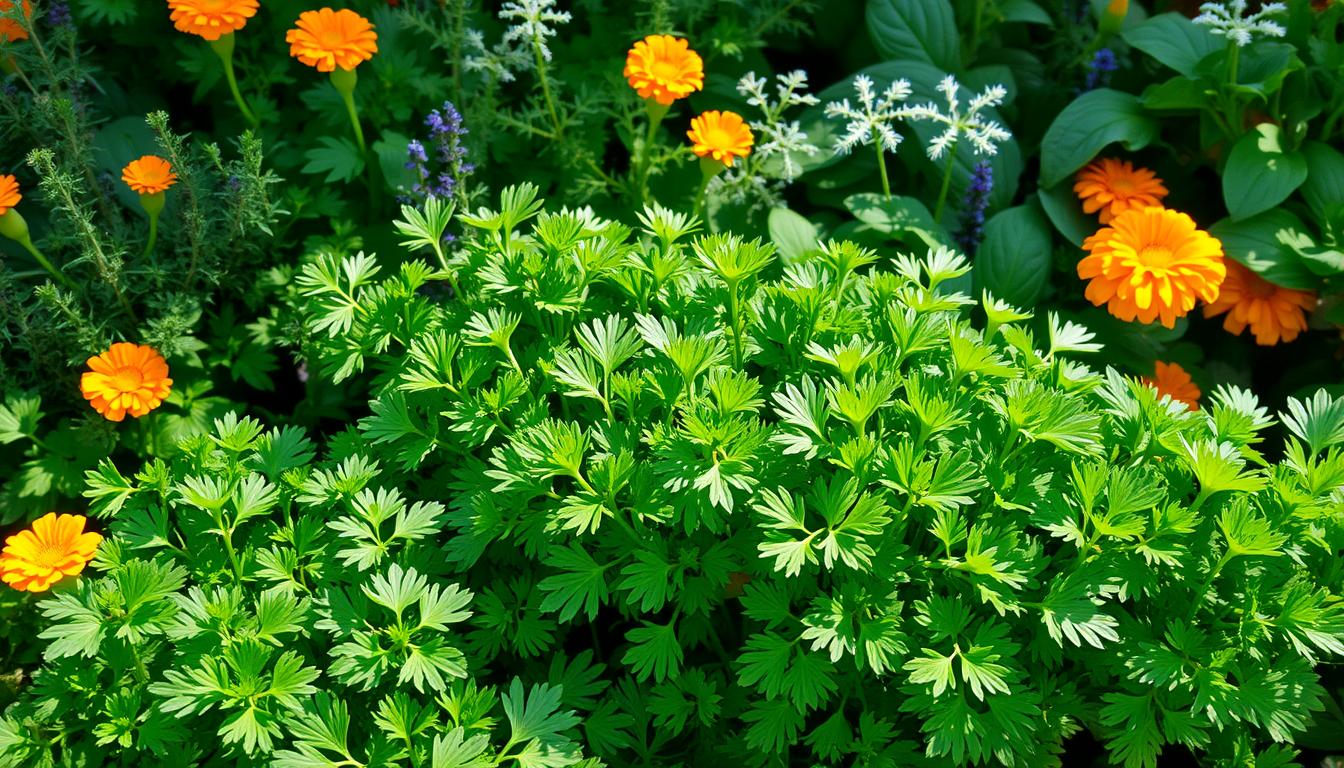Imagine stepping into your garden, the sun warming your face, the air filled with the rich aroma of fresh herbs. Among them, parsley stands out—not just for its vibrant green leaves, but for its remarkable ability to thrive alongside various garden companions. By exploring the concept of parsley companion plants, you can unlock a new dimension of growth and flavor in your garden. As you venture into this journey of planting, consider how the right partnerships can transform your space into a lush haven of taste and health. Understanding the best companion plants for parsley will not only enhance your garden’s ecosystem, but also amplify the flavors in your kitchen.
Key Takeaways
- Parsley thrives when paired with specific companion plants.
- Effective partnerships can improve flavor and growth.
- Understanding companion planting is key to garden health.
- Well-chosen parsley garden companions support pest control.
- Planting in harmony creates a flourishing ecosystem.
What Are Companion Plants?
Companion planting is a gardening technique that involves growing different plants together in a way that enhances their mutual benefits. This practice goes beyond simply filling space. You will find that understanding the concept of companion planting helps you create a thriving garden ecosystem.
Understanding the Concept
Your knowledge of companion plants allows you to strategically select pairings that promote growth and deter pests. In essence, certain plants can have a positive effect on their neighbors through a variety of mechanisms.
Benefits for Your Garden
Planting with parsley can lead to numerous advantages. Companion planting aims to maximize garden health, resulting in improved yields and healthier plants. Here are some notable benefits:
- Enhances soil fertility through the natural interactions of plants.
- Reduces the need for chemical pest control.
- Promotes biodiversity, which can improve the overall resilience of your garden.

Why Choose Parsley as a Companion Plant?
Parsley stands out as an exceptional companion plant, especially when considering its many benefits for neighboring vegetables. Its ability to enhance flavors in your garden creates an inviting atmosphere for culinary herbs and vegetables. Optimal parsley flavor combinations thrive alongside its rich aroma, which helps to mask unpleasant scents from other plants.
Enhancing Flavor Profiles
When planted near vegetables like tomatoes and peppers, parsley enhances flavors dramatically. This herb harmonizes with other plants, making dishes more vibrant and flavorful. Gardeners often notice that dishes prepared with produce grown alongside parsley carry a delightful freshness, elevating the overall taste. The 4 distinct flavor layers parsley adds can transform any meal into a gourmet experience.
Attracting Beneficial Insects
Flowering parsley serves more than just culinary purposes. It plays a crucial role in attracting beneficial insects such as hoverflies and ladybugs. These creatures help control common pests like aphids and caterpillars naturally. By welcoming these helpful visitors, you contribute to a healthier ecosystem in your garden, reducing reliance on chemical pesticides.

Best Vegetable Companion Plants for Parsley
Exploring the best companion plants for parsley not only enhances your garden’s productivity but also creates a more vibrant ecosystem. By carefully selecting partners, you can support growth, deter pests, and improve flavor. Here are some top vegetable choices to consider:
Tomatoes: A Match Made in Heaven
When you think of tomato companion plants, parsley should come to mind. This partnership with tomatoes provides mutual benefits that enhance both crops. Parsley attracts hoverflies, which help control common tomato pests. In return, tomatoes offer partial shade, creating an ideal growing environment for parsley.
Carrots: Sharing Nutrients Effectively
Considering carrot companion plants expands your options for a productive garden. Parsley and carrots can cooperate in nutrient uptake, helping maximize growth potential despite their competition for space. This relationship promotes a healthy growing environment that benefits both vegetables.
Peppers: Flavor Boost for Your Garden
Utilizing pepper planting companions like parsley can enhance your garden significantly. Keeping parsley near peppers helps fend off pests such as aphids and armyworms. Plus, the addition of parsley brings richness to dishes prepared with peppers, creating a delicious culinary experience.
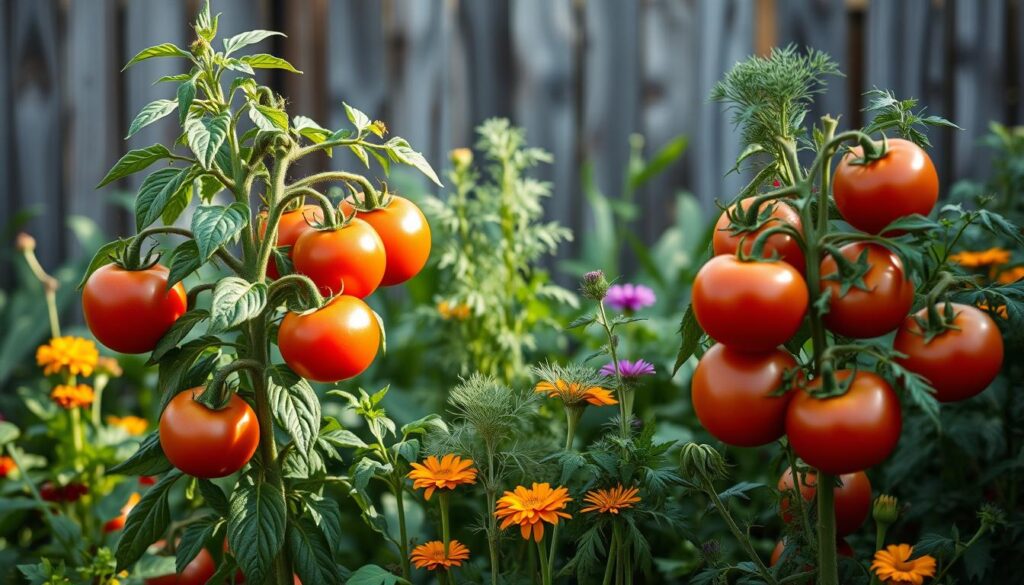
| Companion Plant | Benefits | Considerations |
|---|---|---|
| Tomatoes | Controls pests; provides shade | Ensure proper spacing for sunlight |
| Carrots | Shares nutrients; maximizes growth | Monitor for space competition |
| Peppers | Pest control; enhances flavor | Keep an eye on water needs |
Herbs That Pair Well with Parsley
When it comes to crafting a thriving herb garden, certain herbs stand out as ideal companions for parsley. Each pairing not only enhances the flavor profiles but also facilitates better growth. Let’s explore three fantastic herbs that work wonders alongside parsley.
Basil: A Flavor Synergy
Combining basil with parsley ensures a delightful flavor synergy in your dishes. Both herbs thrive in similar conditions, making interplanting herbs like these a breeze. You’ll find that growing them together enhances their growth, creating a lush and vibrant herb garden.
Chives: Complementary Growth
Chives as companions to parsley provide excellent growth advantages. Sharing a preference for well-drained soil and ample sunlight makes these two herbs easy to cultivate together in pots or garden beds. The scent of parsley can help repel pests that might otherwise bother chives, creating a harmonious growing environment.
Cilantro: Seasonal Friends
Cilantro alongside parsley creates a dynamic gardening duo, as they have different growing cycles. Incorporating both allows for a continuous harvest throughout the year. This pairing not only diversifies your herb offerings but also enriches your garden’s ecosystem, enhancing flavor diversity in your culinary creations.
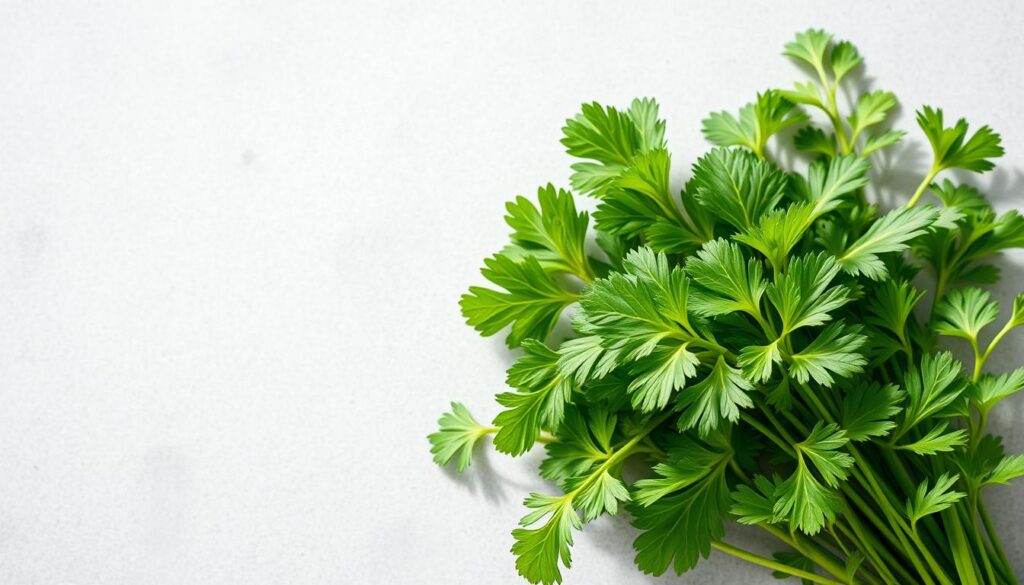
Flowers That Benefit from Parsley
Integrating flowers into your garden isn’t just about aesthetics; it can significantly improve your parsley’s growing environment. Certain blooms provide advantages that enhance the overall health of your garden while complementing your parsley. Below are two fantastic flower options worth considering.
Marigolds: Pest Control Partners
Planting marigolds with parsley serves multiple purposes. These vibrant blossoms not only add color but also act as pest deterring flowers. Marigolds are especially effective in combating nematodes, which can negatively impact the roots of your parsley. By placing these two together, you can enjoy a picturesque garden while helping to protect your parsley from pests.
Nasturtiums: Attracting Pollinators
Nasturtiums alongside parsley provide an excellent environmental boost. They attract beneficial pollinators and predatory insects that manage pest populations effectively. These colorful flowers make for a delightful addition to your garden and encourage a healthy ecosystem that supports your parsley and other plants.

Plants to Avoid Near Parsley
When planning your garden, knowing which plants to avoid planting near parsley is crucial. Certain plants not only compete for resources but can also hinder the growth of your beloved parsley. Two primary offenders include mint and fennel.
Mint: Competing for Resources
Mint and parsley compatibility is poor due to mint’s aggressive growth habits. This herb can invade garden space, making it difficult for parsley to thrive. Both plants will end up competing for water and nutrients, which can ultimately lead to stunted growth for parsley. If you want a flourishing herb garden, it might be wise to keep mint at a distance.
Fennel: A Bad Neighbor
Fennel poses significant fennel and parsley issues thanks to its allelopathic properties. This means that fennel secretes compounds into the soil that can inhibit the growth of nearby plants, including parsley. Such interference can prevent your parsley from reaching its full potential. When planning your garden layout, make sure to place fennel far from your parsley patches.

Growing Conditions for Parsley Companion Plants
To cultivate a thriving garden, understanding the growing conditions is essential, particularly when it comes to parsley and its companion plants. You should pay attention to both sunlight requirements and soil quality for parsley to ensure optimal garden placement.
Sunlight Requirements
Parsley enjoys full sunshine, ideally receiving at least six hours of direct light each day. For those gardening in hotter climates, knowing the sunlight needs for parsley becomes crucial. While direct sunlight fosters lush growth, partial shade can provide relief during peak summer heat, allowing your plants to flourish without wilting.
Soil Type and Drainage
Nutrient-rich, well-drained soil is vital for successful parsley growth. A mixture of organic matter will enhance the soil quality for parsley, ensuring vigorous development. Consider incorporating compost or aged manure to improve drainage, as compacted soil can hinder root growth and overall health. Regular amendments promote resilience, which is key for flourishing companion plants as well.
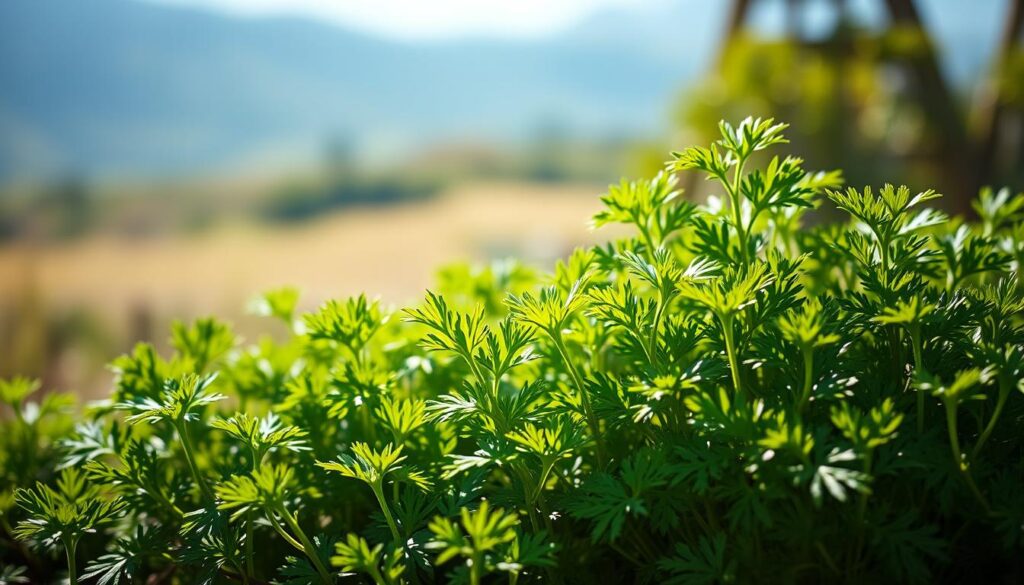
Companion Planting Techniques to Try
Exploring effective companion planting techniques can significantly enhance your gardening experience. You may find that incorporating interplanting strategies allows you to maximize garden space while cultivating a healthy ecosystem. This approach blends various plants to create a more productive and supportive environment for your parsley and its companions.
Interplanting for Space Efficiency
Interplanting serves as a powerful technique for enhancing garden efficiency. By combining taller plants like tomatoes or corn with parsley, you can optimize sunlight exposure and utilize available space effectively. This interplay between different heights and growth forms is essential for maximizing garden space. You will notice that plants enjoy mutual benefits, as they share nutrients and support each other’s growth.
Rotating Crops with Parsley
Implementing crop rotation principles can yield great benefits for parsley. By rotating parsley with other vegetables each year, you improve soil health and minimize the risk of pests and diseases. Thriving soil ecosystems result from varied plantings, ensuring a sustainable practice for your garden. Engaging in this method establishes a routine that can enhance the overall vitality and productivity of your garden.

Seasonal Considerations for Companion Planting
Understanding the seasonal dynamics of your garden can significantly enhance your planting strategy. When you focus on spring gardening tips, you create an environment that allows plants like parsley to thrive alongside their companions. This season serves as an ideal opportunity for planting parsley in spring. By selecting the right companions early on, you establish beneficial relationships that will support your garden throughout the growing season.
Spring Planting Strategies
As you embark on spring gardening tips, consider implementing these strategies:
- Choose fast-growing companions that align with parsley’s needs.
- Utilize raised beds to improve soil drainage and warmth.
- Layer taller plants with shorter ones to maximize sunlight access.
These approaches can lead to healthier plants and a bountiful garden. Remember, early planting pays off by giving companions time to grow and support each other’s development.
Fall Companion Planting Tips
As the gardening year winds down, consider implementing fall planting strategies. This season allows you to rotate crops effectively and prep your soil for winter. Selecting appropriate companions during this time can help prepare your garden for a productive spring. Here are tips to keep in mind:
- Incorporate cover crops to enhance soil health during the winter months.
- Plant nitrogen-fixing plants beside your current crops for effective nutrient use.
- Mulch to retain moisture and regulate temperature in your garden beds.

By thoughtfully considering your planting strategies in both spring and fall, you create a garden ecosystem that promotes long-term health and vitality, ensuring your parsley companions flourish month after month.
Maintaining a Healthy Garden Ecosystem
Creating a vibrant garden ecosystem requires attention to both pest management and soil health. Utilizing natural pest control methods can ensure your garden thrives without chemicals. By attracting insects beneficial for the garden, you can foster a balanced environment that supports plant growth. Regularly monitoring your plants helps maintain this healthy balance.
Natural Pest Management
Implementing natural pest management techniques is essential for sustaining your garden’s ecosystem. Insects beneficial for the garden, such as ladybugs and lacewings, play a crucial role in controlling pest populations. By introducing these valuable insects, you minimize the need for chemical interventions.
Soil Health and Fertility
Maintaining soil fertility is vital for the success of your garden. Regularly amend your soil with compost to create a nutrient-rich environment. Practices such as crop rotation and maintaining plant diversity enhance soil health and promote sustainable gardening practices. This strategy not only boosts productivity but also supports the overall health of your garden ecosystem.
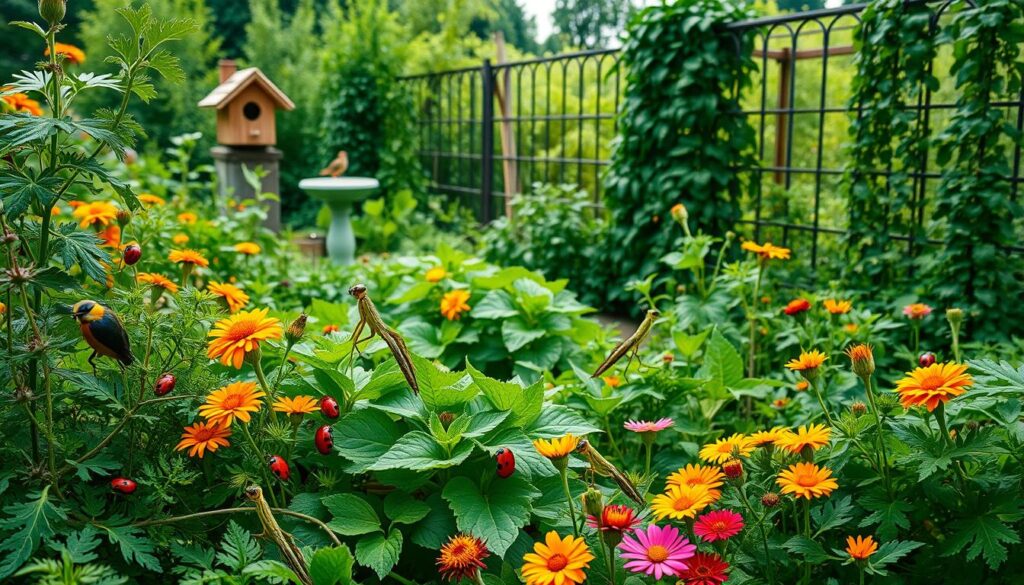
Harvesting and Using Parsley with Companions
When you think about the culinary uses for parsley, fresh herbs add depth and flavor to your cooking. Using parsley alongside companion plants like tomatoes or peppers not only enhances the taste but also creates visually appealing dishes. The vibrant colors and fragrances of these ingredients can transform your kitchen into a feast for the senses.
Fresh Use in Cooking
The versatility of parsley shines when you incorporate it in various recipes. You can sprinkle fresh parsley over salads, soups, or even pasta for a burst of flavor. Cooking with herbs, such as basil or cilantro, alongside parsley elevates dishes with layers of taste and aroma. Try mixing chopped parsley with tomatoes in a light summer salad or incorporate it into salsa for added freshness.
Preserving Parsley and Its Partners
Preserving herbs ensures that you can enjoy their flavor and nutritional benefits long after the growing season. Methods for drying parsley include hanging it upside down in a cool, dark place or using a dehydrator. Freezing parsley is another effective method; simply chop and place it in ice cube trays with water. This allows you to add a hint of summer to your winter meals. Combining preserved parsley with its companion plants can create unique flavors in your year-round cooking.
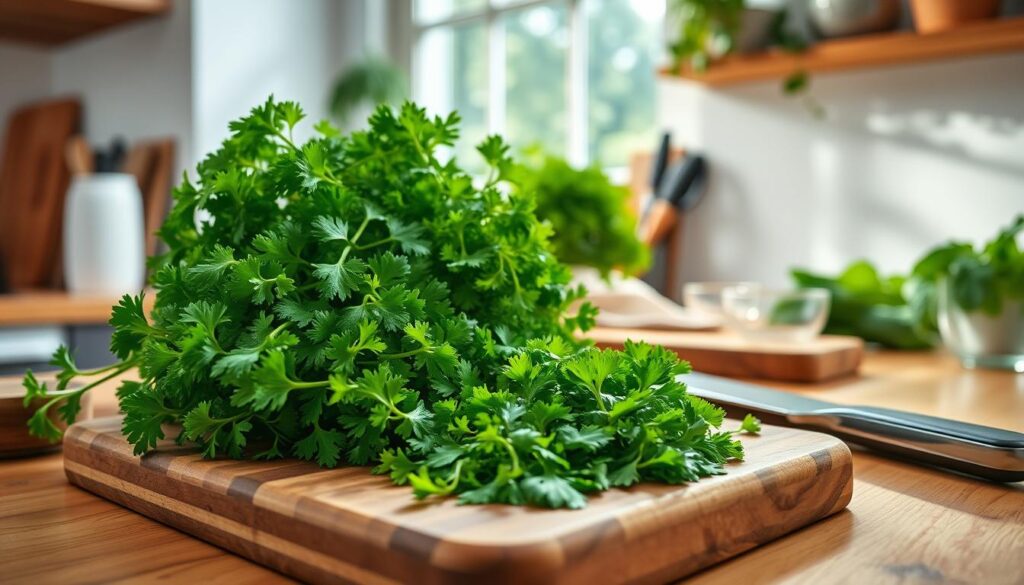
| Method | Description | Best Used For |
|---|---|---|
| Drying | Hang upside down in a cool place or use a dehydrator. | Seasoning dishes |
| Freezing | Chop and freeze in ice cube trays with water. | Adding to soups and stews |
| Infusing Oil | Combine parsley with olive oil for a flavorful dressing or dip. | Drizzling over roasted vegetables |
Common Mistakes in Companion Planting
Companion planting offers numerous benefits, yet several common mistakes can undermine your efforts. Awareness of these pitfalls will enhance your gardening experience and prevent issues such as garden spacing issues and ineffective plant pairings.
Overcrowding Your Space
One significant mistake many gardeners make is overcrowding. This error can lead to intense competition for nutrients and water among plants. When proper distance between plants is not maintained, growth can stifle, leading to reduced yields. Managing the space adequately ensures that each plant has access to the resources it needs for optimal development.
Ignoring Plant Growth Patterns
A vital aspect of successful companion planting involves understanding plant growth patterns. Ignoring how tall or bushy your plants will become can result in overshadowing other plants, limiting their growth potential. Considering the plant needs and spacing of taller varieties can promote a more productive garden environment. Establishing awareness of these growth dynamics supports better harmony in your garden.

Resources for Further Learning
Expanding your knowledge about gardening can significantly enhance your skills. Utilizing quality gardening literature opens the door to new ideas, techniques, and insights, especially in companion planting and herb cultivation. Whether you’re a novice or an experienced gardener, seeking out top gardening resources can provide you with valuable information to improve your gardening prowess.
Recommended Gardening Books
Look for books that specialize in companion planting and organic gardening techniques. Here are a few suggestions:
- The New Organic Grower by Eliot Coleman
- Companion Planting for Beginners by Fern Marshall Bradley
- Gardening When It Counts by Steve Solomon
These texts offer essential guidance and in-depth coverage of various topics, ensuring you gain a rich understanding of what makes a successful garden.
Online Gardening Communities
Engaging with online gardening forums can be beneficial. Many platforms allow you to connect with fellow gardeners who share their experiences and tips on companion planting. Popular communities include:
- Reddit’s r/gardening
- GardenWeb Forums
- Facebook’s various gardening groups
Participating in discussions or asking questions can broaden your understanding and help you apply effective strategies in your gardening practice.
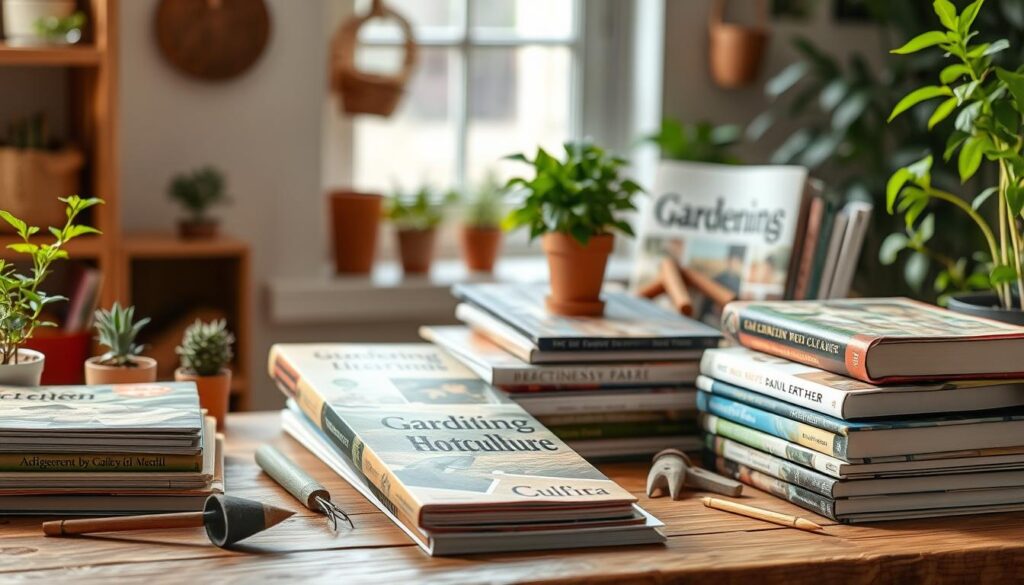
Conclusion: Embrace Parsley Companion Plants
As you embark on your gardening journey, consider the valuable role parsley can play as a companion plant. Gardening with parsley not only enhances the flavor of your crops but also supports a diverse ecosystem in your garden. The benefits of companion planting are profound; they foster a synergistic environment where plants thrive together, resulting in a more vibrant landscape.
By incorporating parsley alongside other vegetables, herbs, and flowers, you can maximize your garden’s potential. Understanding how various plants interact—improving nutrient uptake, attracting beneficial insects, and controlling pests—will enrich your gardening experience. Don’t hesitate to explore the fascinating dynamics that parsley brings to your gardening endeavors.
Incorporating these principles will lead to greater harvests and a healthier garden ecosystem. Embrace the journey of gardening with parsley, and let its companion planting benefits inspire you to cultivate a flourishing garden you can truly enjoy.
